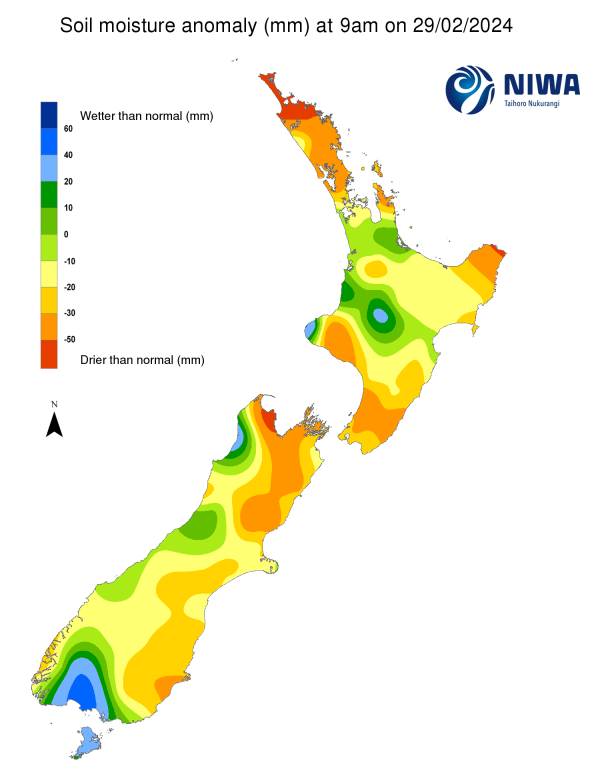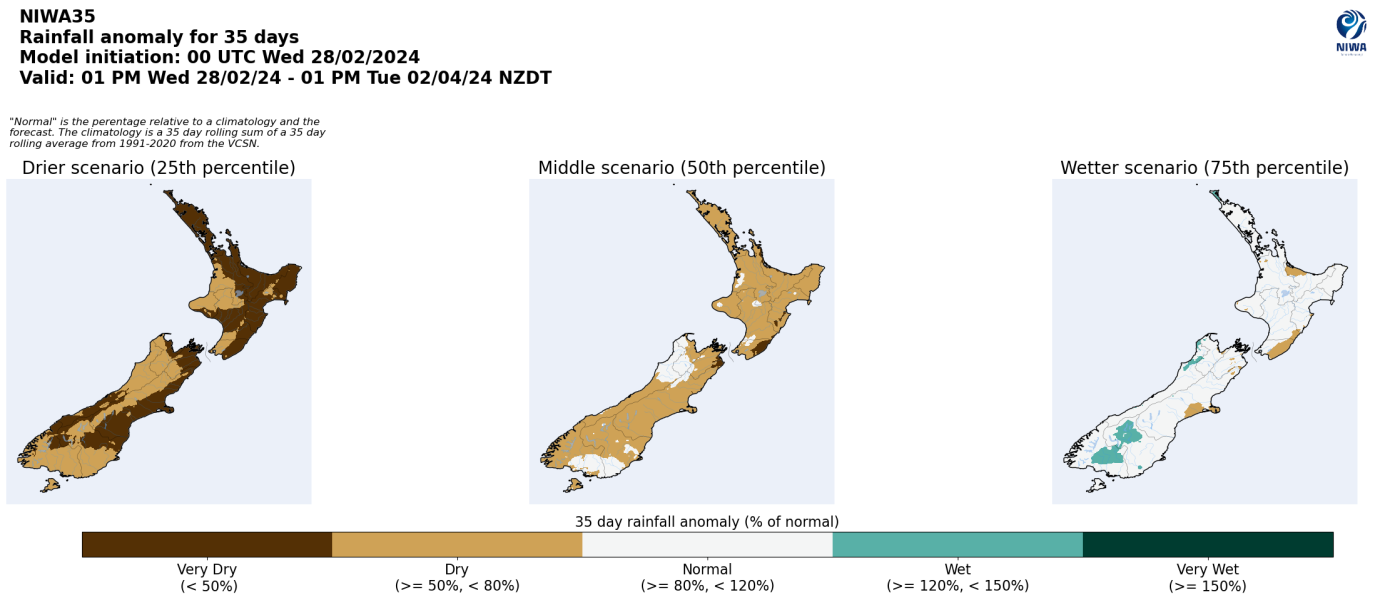A weekly update describing soil moisture patterns across the country to show where dry to extremely dry conditions are occurring or imminent. Regions experiencing significant soil moisture deficits are deemed “hotspots”. Persistent hotspot regions have the potential to develop into drought.
Recent rainfall and current soil moisture conditions:
North Island:
- Much of the North Island saw rainfall totals of 10-25 mm in the past week, with parts of the central North Island receiving 25-40 mm.
- However, areas in the Far North and Wairarapa saw more meagre amounts of 10 mm or less.
- This resulted in small to moderate soil moisture increases in the central North Island in the past week, while other areas generally saw little change.
- The driest soils across the North Island, when compared to normal for this time of the year, are found in the Far North, while the wettest soils for this time of the year are found in southern Waikato and western Taranaki.
- Hotspots are now located across much of Northland, northern Auckland, northern Coromandel Peninsula, East Cape and coastal Gisborne, coastal Manawatū-Whanganui, and Wellington-Wairarapa.
- As of 28 February, the New Zealand Drought Index (NZDI) map below shows that abnormally dry conditions are currently found in Northland, Auckland, part of the Coromandel Peninsula, eastern Bay of Plenty, East Cape, and much of the lower North Island. Very dry to extremely dry conditions are located in eastern Northland, far southern Manawatū-Whanganui, and Wellington.
South Island:
- Rainfall amounts of 25-60 mm affected the West Coast and Tasman in the past week, with isolated areas receiving 75 mm or more.
- However, the rest of the South Island saw generally meagre rainfall amounts of 5-15 mm.
- This resulted in small to moderate soil moisture decreases across a majority of the South Island.
- The driest soils across the South Island, when compared to normal for this time of the year, are found in northern Tasman, while the wettest soils for this time of the year are found in western Southland.
- Hotspots are currently located across much of the upper and eastern South Island, including eastern Tasman, Nelson, Marlborough, northern and southern Canterbury, and eastern Otago. In addition, central Canterbury and interior Otago are close to hotspot status.
- As of 28 February, the New Zealand Drought Index (NZDI) map below shows that abnormally dry conditions are currently found in eastern Tasman, Nelson, Marlborough, northern and far southern Canterbury, and northern Otago. Very dry to extremely dry conditions are located in Nelson, Marlborough, northern and far southern Canterbury, and northern Otago.
Pictured above: Soil Moisture Anomaly Maps, relative to this time of year. The maps show soil moisture anomalies over the past two weeks.
As of 28 February, the New Zealand Drought Index (NZDI) map below shows that abnormally dry conditions are currently found in Northland, Auckland, part of the Coromandel Peninsula, eastern Bay of Plenty, East Cape, much of the lower North Island, eastern Tasman, Nelson, Marlborough, northern and far southern Canterbury, and northern Otago. Very dry to extremely dry conditions are located in eastern Northland, far southern Manawatū-Whanganui, Wellington, Nelson, Marlborough, northern and far southern Canterbury, and northern Otago. Please note: some hotspots in the text above may not correspond with the NZDI map. This difference exists because the NZDI uses additional dryness indices, including one which integrates the rainfall deficit over the past 60 days. Changes are therefore slower to appear in the NZDI compared to soil moisture anomaly maps that are instantaneously updated.
The week ahead:
North Island:
- Mostly dry weather is expected through Saturday, but a front will bring periods of moderate rain to the western and northern North Island on Sunday (3 March).
- Monday (4 March) looks to be very wet across the island, with widespread moderate to heavy rainfall.
- After a few more showers on Tuesday (5 March), the next few days are expected to be dry once again.
- Widespread weekly rainfall totals could reach 30-50 mm in much of the central and western North Island, with some areas potentially receiving 50-80 mm. However, parts of Northland and the east coast may see substantially less rainfall, in the range of 20 mm or less.
- Due to the expected rainfall in the next week, substantial soil moisture increases may occur in western and central regions, while parts of Northland and the east coast may see additional decreases.
- The current hotspots in Northland and the eastern North Island could see additional strengthening in the next week, but in Auckland and Manawatū-Whanganui the hotspots may ease somewhat.
South Island:
- Some showers will affect the West Coast and lower South Island during the weekend (2-3 March), but other areas will be dry.
- Low pressure will bring moderate to heavy rain to much of the island on Monday (4 March), with the West Coast and lower South Island seeing additional showers on Tuesday.
- Thereafter, mostly dry weather is expected during mid-to-late next week.
- Weekly rainfall totals of 75-120 mm are likely in the West Coast, including Fiordland, with 40-60 mm for Southland and interior Otago.
- However, regions such as Nelson, Marlborough, and Canterbury will likely see lighter rainfall totals of 10-25 mm.
- Due to the expected rainfall in the next week, additional soil moisture decreases are possible in the upper and eastern South Island (especially near the coast), but the West Coast and lower South Island may see soil moisture increases.
- Most current hotspots may strengthen in the next week, although those in Otago may ease at least slightly. However, additional hotspots may form in central Canterbury.
Long-term outlook (through early April):
- The drier (25th percentile) and middle (50th percentile) rainfall scenarios both show drier or much drier than normal conditions across much of the country.
- Even in the wetter (75th percentile) scenario, below normal rainfall is still forecast in isolated areas, but near normal rainfall is most favoured across the country.
- Very dry soil conditions could affect the lower North Island and eastern South Island in all three rainfall scenarios, along with the upper North Island in the drier scenario. The drier scenario also shows the possibility for a small area of meteorological drought to form in the lower South Island.
Pictured above: 35-day forecast rainfall anomaly scenarios (Top), and 35-day forecast dryness and drought scenarios (Bottom). These maps are updated daily at https://niwa.co.nz/climate/seasonal-climate-outlook
Background:
Hotspot Watch: a weekly advisory service for New Zealand media. It provides soil moisture and precipitation measurements around the country to help assess whether extremely dry conditions are imminent.
Soil moisture deficit: the amount of water needed to bring the soil moisture content back to field capacity, which is the maximum amount of water the soil can hold.
Soil moisture anomaly: the difference between the historical normal soil moisture deficit (or surplus) for a given time of year and actual soil moisture deficits.
Definitions: “Extremely” and “severely” dry soils are based on a combination of the current soil moisture status and the difference from normal soil moisture (see soil moisture maps at https://www.niwa.co.nz/climate/nz-drought-monitor/droughtindicatormaps)
Hotspot: A hotspot is declared if soils are "severely drier than normal" which occurs when Soil Moisture Deficit (SMD) is less than -110 mm AND the Soil Moisture Anomaly is less than -20 mm.

![Soil moisture anomaly map (mm) at 9am on 22 February 2024. [NIWA]](/sites/default/files/styles/portrait/public/inline-images/smdanom_20240222.png?itok=g42-w9Ry)




